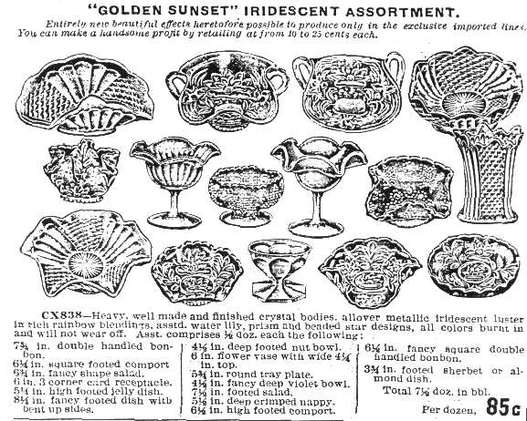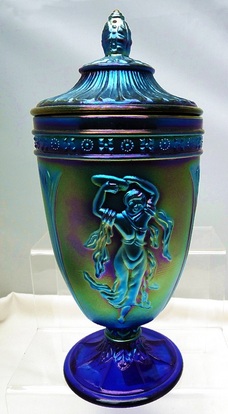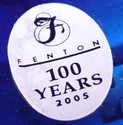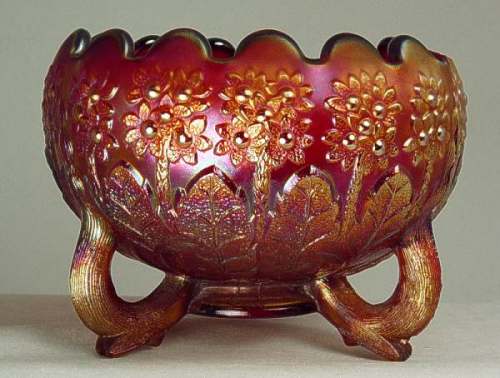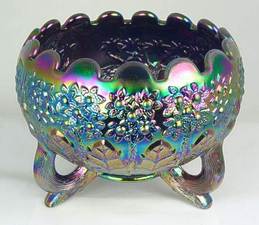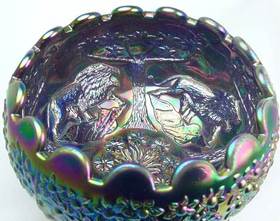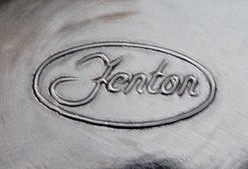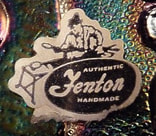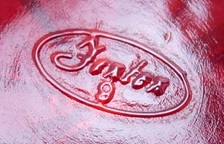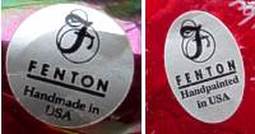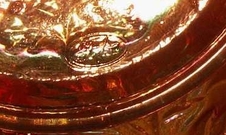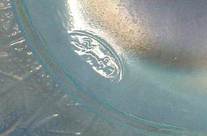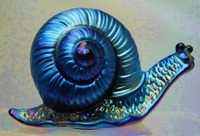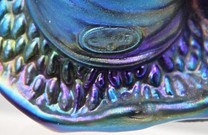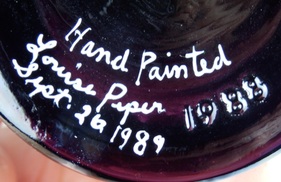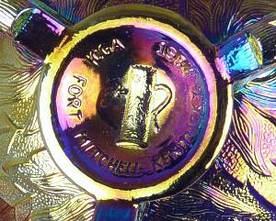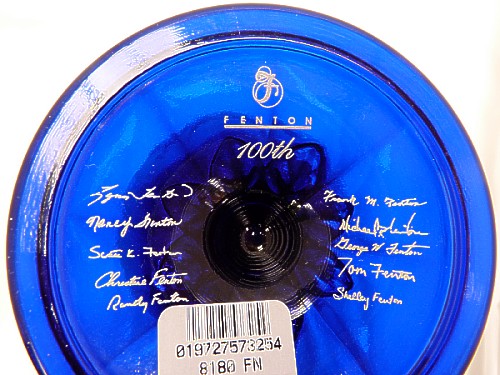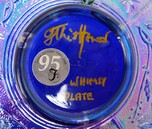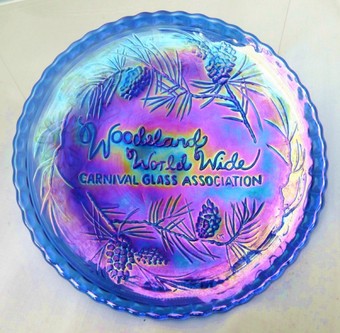Fenton Old and New
Fenton Art Glass made Carnival Glass originally from 1907 through to the late 1920s. In the 1970s, they revived the techniques of making Carnival and re-introduced Carnival Glass products that have become best sellers and known throughout the world. They used their own original moulds, moulds they had bought from other glassmakers that had gone out of business (such as Imperial), and many, many new moulds that they made in their own mould shops, or jobbed out to other mould makers.
The picture above, left, is the very first wholesale ad that we are aware of for Fenton's Classic Carnival Glass (courtesy of the late Frank M Fenton). The colour, "Golden Sunset Iridescent Assortment", was surely marigold! The patterns shown in this splendid 1908 ad include: Waterlily and Cattails, Beaded Stars and Diamond Point Columns. The following year, another Fenton ad appeared, showing: Stippled Rays, Honeycomb and Clover, Coin Dot, and a compote in the seldom seen geometric pattern Finecut Flower.
So, from the earliest Fenton ad, to more recent times - below left is a Classic, old Fenton Orange Tree (aka Fenton's Flowers) rosebowl in (rare) red Carnival Glass. When Fenton re-issued it with the name Leaf and Orange Tree (centre), they used the same mould / exterior pattern, but they used a different plunger / interior pattern (right) which is their Lions pattern. Interestingly, Lions is also a Classic Fenton pattern, but in the Classic period it was not used as the interior of this rosebowl - the original Lions pattern was made in regular bowls and plates only with Berry and Leaf Circle exterior.
So, from the earliest Fenton ad, to more recent times - below left is a Classic, old Fenton Orange Tree (aka Fenton's Flowers) rosebowl in (rare) red Carnival Glass. When Fenton re-issued it with the name Leaf and Orange Tree (centre), they used the same mould / exterior pattern, but they used a different plunger / interior pattern (right) which is their Lions pattern. Interestingly, Lions is also a Classic Fenton pattern, but in the Classic period it was not used as the interior of this rosebowl - the original Lions pattern was made in regular bowls and plates only with Berry and Leaf Circle exterior.
Fenton announced the return of Carnival Glass in 1970.
When, in 1970, Fenton reintroduced Carnival Glass into the line, they decided to trademark the new output with the word Fenton in script in an oval cartouche - see far left, below - so that "collectors of early Classic Fenton Carnival, which was all unmarked, could tell the difference". We show many Fenton Revival Carnival Glass catalogues here on our website, including the very first one that they issued in 1970 - here it is: January 1970 Supplement.
In making the decision to mark their reintroduction of Carnival, Frank Fenton (President of Fenton Art Glass) was influenced by one of the pioneers of Classic, old Carnival Glass - Rose Presznick. Rose asked Fenton to make a contemporary souvenir, but insisted that it was trademarked Fenton. Frank agreed! Read all about the pioneering influence of Rose and Joe Presznick and their Carnival Glass Museum.
The idea of using a logo on Carnival proved so popular that there was a call for its use on all glass, in the the line, and the company adopted this idea in 1974. Thus all Fenton line items made since 1974 have the Fenton logo impressed on them. ("Fenton Glass: The Third Twenty Five Years" Wm. Heacock).
In making the decision to mark their reintroduction of Carnival, Frank Fenton (President of Fenton Art Glass) was influenced by one of the pioneers of Classic, old Carnival Glass - Rose Presznick. Rose asked Fenton to make a contemporary souvenir, but insisted that it was trademarked Fenton. Frank agreed! Read all about the pioneering influence of Rose and Joe Presznick and their Carnival Glass Museum.
The idea of using a logo on Carnival proved so popular that there was a call for its use on all glass, in the the line, and the company adopted this idea in 1974. Thus all Fenton line items made since 1974 have the Fenton logo impressed on them. ("Fenton Glass: The Third Twenty Five Years" Wm. Heacock).
|
Fenton also used a paper label showing a master glassmaker (centre), although some will undoubtedly have washed off over time. Throughout the 1970s the logo was simply "Fenton" within the oval, then during the 1980s, a number 8 was added, in the 1990s, a 9 - see right. In the 2000s it became a 0 (zero).
Sometimes Fenton used moulds that they had bought from other companies, or on moulds that are owned by others - in which circumstances, they use a single cursive letter F to mark the items. The script F is in an upright oval - shown on the right - and it is found on glass that was used when other makers' moulds, (such as the McKee ones), were used by Fenton. However, note that the Verlys moulds (acquired from Holophane) and also those from Paden City and U.S. Glass, were not marked this way - they have the full "Fenton" word in a cartouche. From 2007 onwards, Fenton had two brands - Fenton USA and Fenton International. (The former was all made in the USA, and the latter mostly in China). Here's what George Fenton wrote in 2009 explaining how this had affected their markings: "Incidentally, we add "USA" to each of our moulds as we use them, either below or beside the Fenton logo. A small "1" designates pieces made in 2010 and will continue through 2019". (quote George Fenton). |
The Fenton cursive logo used on most moulds acquired from other glass companies and on moulds owned by other parties (see text).
|
Only a few items have different marks, or rarely none at all. However, from time to time, the Fenton mark may be tricky to find, as it may have been discretely tucked into the design and isn't obvious at first glance. It's also possible that the reheating operations during production of a piece may almost obliterate the mark - but the oval shape can still be detected. Take for example Fenton's 6 inch marigold Carnival "Grape" bowl - it is on the far left, below. Finding the logo on that piece has proved to be a challenge - but it's there alright! Howard Seufer's photo clearly shows where the logo can be found - it's on the underside of the piece just inside the rim of the marie. There is a leaf stem on the inside that just overlays one end of the outside logo. Or look at the aqua opal piece, second left, below. The pattern or the reflection of the glass can trick the eye, but the photos show that the logo is there if you look for it. (Photos courtesy of Howard Seufer).
Another logo that is hard to find. This is a Fenton snail in gorgeous favrene (third left). The underside of the snail is ground so that the piece sits flat, so any logo there would be lost. Instead, the Fenton cartouche is carefully placed on the lower back of the snail's shell, far right.
Another logo that is hard to find. This is a Fenton snail in gorgeous favrene (third left). The underside of the snail is ground so that the piece sits flat, so any logo there would be lost. Instead, the Fenton cartouche is carefully placed on the lower back of the snail's shell, far right.
Over recent years, Fenton has used a variety of ways of marking their glass, either to recognise a special event, a particular milestone in their history, or for the Carnival clubs and collector markets. A popular Fenton technique was to decorate some of their glass, particularly Carnival clubs' commemoratives and whimseys (which were generally sold off to raise funds for the club - below left is the base of a miniature Morning Glory pitcher, painted and signed by one of Fenton's most skilled decorators - Louise Piper.
In the centre is a club commemorative for ICGA (International Carnival Glass Association) in 1984 - Fenton made a special base plate for the mould with the commemorative information on it.
Below, right is the base of the very special piece of Fenton glass - the "Dancing Ladies" urn, shown at the top of the page. It was designed in the mid-1920s by Frank L Fenton and inspired by an earlier piece made by H Northwood Co. Dancing Ladies pieces were originally produced by Fenton in various colours in the 1920s and 30s. In 2004 the design was adapted for this new covered urn, offered exclusively in Favrene, which contains pure silver, and each piece is unique. Each piece also had the special Fenton 100 Years label, and was signed on the base by members of the Fenton family - as shown. The pieces were only available to customers who bought Fenton's special 100th. anniversary book "FENTON: Handcrafted American Glass Artistry."
In the centre is a club commemorative for ICGA (International Carnival Glass Association) in 1984 - Fenton made a special base plate for the mould with the commemorative information on it.
Below, right is the base of the very special piece of Fenton glass - the "Dancing Ladies" urn, shown at the top of the page. It was designed in the mid-1920s by Frank L Fenton and inspired by an earlier piece made by H Northwood Co. Dancing Ladies pieces were originally produced by Fenton in various colours in the 1920s and 30s. In 2004 the design was adapted for this new covered urn, offered exclusively in Favrene, which contains pure silver, and each piece is unique. Each piece also had the special Fenton 100 Years label, and was signed on the base by members of the Fenton family - as shown. The pieces were only available to customers who bought Fenton's special 100th. anniversary book "FENTON: Handcrafted American Glass Artistry."
|
This is another truly special piece! An internet Carnival Glass club, Woodsland World Wide Carnival Glass Association (now sadly no longer in existence) commissioned Glen Thistlewood on a pro-bono basis, to design their club's commemorative. Glen, the first President of the club, designed both the interior pattern - "Woodsland Pine" shown on the right, and the exterior pattern "Flowers of the World". Glen worked closely with the team at Fenton who made the "Flowers of the World" mould, and who have made what has been the club's hugely successful commemorative pieces. A special honour by the mouldmaker was to incorporate Glen's initials (GT) into the design itself - see below left. Read the amazing story of the design and making of "Woodsland Pine / Flowers of the World" |
Read more about Fenton's Classic and Revival (Contemporary) Carnival Glass
